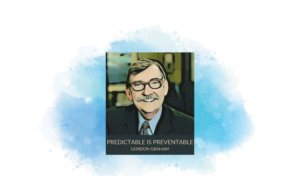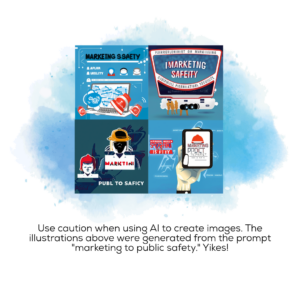
We’ve all been there. You work for months on a marketing campaign, only to deploy it to a resounding chorus of crickets. Zero response. Or maybe you’ve crafted an email that you hope will gain you new business, only to be met with radio silence. The cruelest part of making a misstep in your communications is that you often don’t know when you’ve said or written something that put off a customer or stakeholder.
In short, words matter. And they definitely matter in public safety. Here are six guidelines to keep in mind as you create marketing communications to effectively connect with public safety leaders and others in the field:
Consider your credibility with public safety.
Trust is at the foundation of public safety. After all, if you’re making software that, say, runs 911 or interacts with ambulances, your product — and you, as the people making and marketing that product — must be reliable and trustworthy. To that end, make sure your website, press releases, product briefs and any and all communications are accurate, free of spelling and punctuation errors and grammatically correct.
Word choice (as we’ll see) matters, too. If language and writing aren’t your strengths, find someone to back you up, even if you hire an outside contractor. In the same vein, if you make assertions in your marketing collateral, like you’re top-rated in your field or have X percentage of market share, back up those claims with third-party data whenever possible.
Strike the right tone with public safety.
Did your mom ever tell you, “It’s not what you say, it’s how you say it”? This is where tone comes in, and it can be a fine line to walk. Aim for your content to strike a balance between formal and respectful, while still conversational and to-the-point. Avoid anything that’s too cutesy, clever, full of marketing-speak or overly technical. (The latter depends on your audience, of course. If you’re a software company sending specs to engineers, you’ll want to get technical. But the same language can be off-putting and unnecessary for a fire chief.)
When it’s done well, humor can work wonders, but tread carefully here. What you find funny may not seem so to someone else and could even be confusing or make you appear unprofessional.
Beware of jargon.
Let’s be honest, public safety is full of jargon, acronyms and shorthand that outsiders couldn’t hope to understand. But plain language that’s free of insider terms should still be your rule of thumb. If you need to use an acronym or abbreviation, be sure to spell it out the first time. Don’t assume your readers or users will know what it is. Words and phrases like “burn rate” and “optimization” may seem like they build your authority and credibility but they could simply make you sound like a consultant, and not someone who understands what a police or fire chief really needs from your product.
Understand your sector.
You’ve probably heard the expression “know your audience,” and there’s no truer or more important advice in communication of any kind. Every sector in public safety — fire, law enforcement, emergency medical services (EMS) and 911 — is different. If you’re writing to reach first responders, that’s not the same as reaching public safety leadership.
A good way to improve your understanding of each sector is to subscribe to newsletters published by industry trade media, associations and other professional organizations. You’ll learn their language, what’s important and current and how they like to be communicated with. A February 2021 survey by Officer.com of law enforcement leaders, for example, found that school active-shooter events, a resurgence of COVID-19 and natural disasters are what this community is most worried about now. Getting an insider view of your customers’ concerns and priorities could mold the direction and tenor of your communications.
It’s also worth asking a subject matter expert to do a technical review of what you create before you put it out in the world. Ask your SME, “Does this sound authentic and genuine? Is it clear? Do you think it will resonate with someone in this sector?” This person can also stop unintentional gaffes, like calling EMS staff “ambulance drivers,” considered a derogatory term for these skilled, trained professionals.
Remember that less is more.
A few years ago, we worked with a CEO who’d once been a fire chief. He would craft many of the company’s social media posts, taking great care and thought in creating even a 30-word tweet. He wanted the content to be trustworthy, but he also knew that there’s so much “noise” these days, as people are inundated with emails, posts, and endless other types of content. So whenever a company can cut through that to say something meaningful, that’s a very good thing.
Say what you need to say as concisely as you can. If half as many words will do, slice your content down accordingly; your audience will appreciate it. And if a visual — photo, infographic, chart — will get your point across faster and better, use that instead. Just be careful when picking up stock photography; be sure whatever you’re showing is relevant and accurate for your audience.
Proceed with caution when choosing a name.
We’ve all seen brands with names that are cute or fun but hard to remember and sometimes simply confusing. As a rule (but not always) simplicity wins the day when deciding what to call something. Remember that you’re bringing brand equity to whatever name you choose, so while functional names can seem less interesting, they tend to work best. Which are you likelier to understand and recall: GovTech’s Mobile PSAP or GovTech’s SuzieQ911? Similarly, just because your engineers have a pet name for a project, doesn’t mean you need to use it when you’re ready to go to market. Like humor, inside jokes too often fall flat.
With these simple reminders you will be able to steer clear of the most common public safety communications mistakes that might cost you the goodwill of your clients or even their business.
Related Posts
-
It’s easy in tough economies to want to bypass strategy and go straight to tactics.…
-
Selling to public safety is not the same as selling in other industries. Discover 3…
-
Hockey legend Wayne Gretzky once said: “Skate to where the puck is going, not to…









 The RedFlash Group is a GSA Contract Holder under Schedule 541, Advertising and Integrated Marketing Solutions
The RedFlash Group is a GSA Contract Holder under Schedule 541, Advertising and Integrated Marketing Solutions